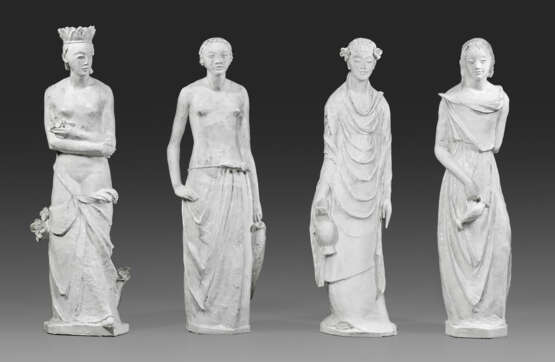ID 218563
Lot 226 | Josef Wackerle
"Vier Erdteile". Originaltitel
Lebensgroße, weiß glasierte Majolika- bzw. Fayencefiguren. Auf mehrfach gekanteter Plinthe stehende, schauseitig konzipierte, weibliche Figuren in locker drapierten Gewändern, die vier Kontinente Amerika, Afrika, Asien und Europa personifizierend. Charakteristisch für diese Figuren und allgemein die Formensprache Wackerles in den 20er Jahren ist eine blockhafte Stilisierung mit oft eckig umbrechenden Falten sowie mandelförmige Augen. Die "Vier Erdteile" wurden von Wackerle ursprünglich als Pfeilerfiguren des sog. "Majolika-Tempels" für die Manufaktur Nymphenburg entworfen - aufgestellt in der Hauptausstellungshalle der "Deutschen Gewerbeschau" 1922 in München. International gezeigt wurden die Figuren 1927 auf der berühmten III. Internationalen Kunstgewerbeausstellung in Monza sowie in der Ausstellung "Europäisches Kunstgewerbe 1927" im Leipziger Kunstgewerbemuseum (Grassi-Museum). Eine Figur unw. best.; H. 159 cm - 164 cm.
Literatur: Deutsche Kunst und Dekoration, Bd. 50 (1922), S. 276ff. (mit Abbildung); Bd. 60 (1927) S. 338ff. (mit Abbildung); "Europäisches Kunstgewerbe: Berichte über die Ausstellung Europäisches Kunstgewerbe 1927", Leipzig 1928, Taf. 106; Ziffer: Katalog "Nymphenburger Moderne", S. 278ff., Abbildung S. 282, Katalog-Nr. 378 (spätere Ausführung).
Provenienz: Aus der Privatsammlung einer Ärztefamilie in Bochum.
Four lifesize white glazed German maiolica figures representing the Four Continents. Modelled by Prof. Josef Wackerle in 1922. Exhibited in Munich 1922, further in Monza and Leipzig 1927. One figure insignificantly chipped.
Nymphenburg. Um 1922 - 1927.
| Auction house category: | Sculptures |
|---|
| Auction house category: | Sculptures |
|---|
| Address of auction |
Kunstauktionshaus Schloss Ahlden GmbH Große Str. 1 29691 Ahlden(Aller) Germany | ||||||||||||||
|---|---|---|---|---|---|---|---|---|---|---|---|---|---|---|---|
| Preview |
| ||||||||||||||
| Phone | +49 5164 80100 | ||||||||||||||
| Buyer Premium | 25.0 | ||||||||||||||
| Conditions of purchase | Conditions of purchase | ||||||||||||||
| Business hours | Business hours
|



